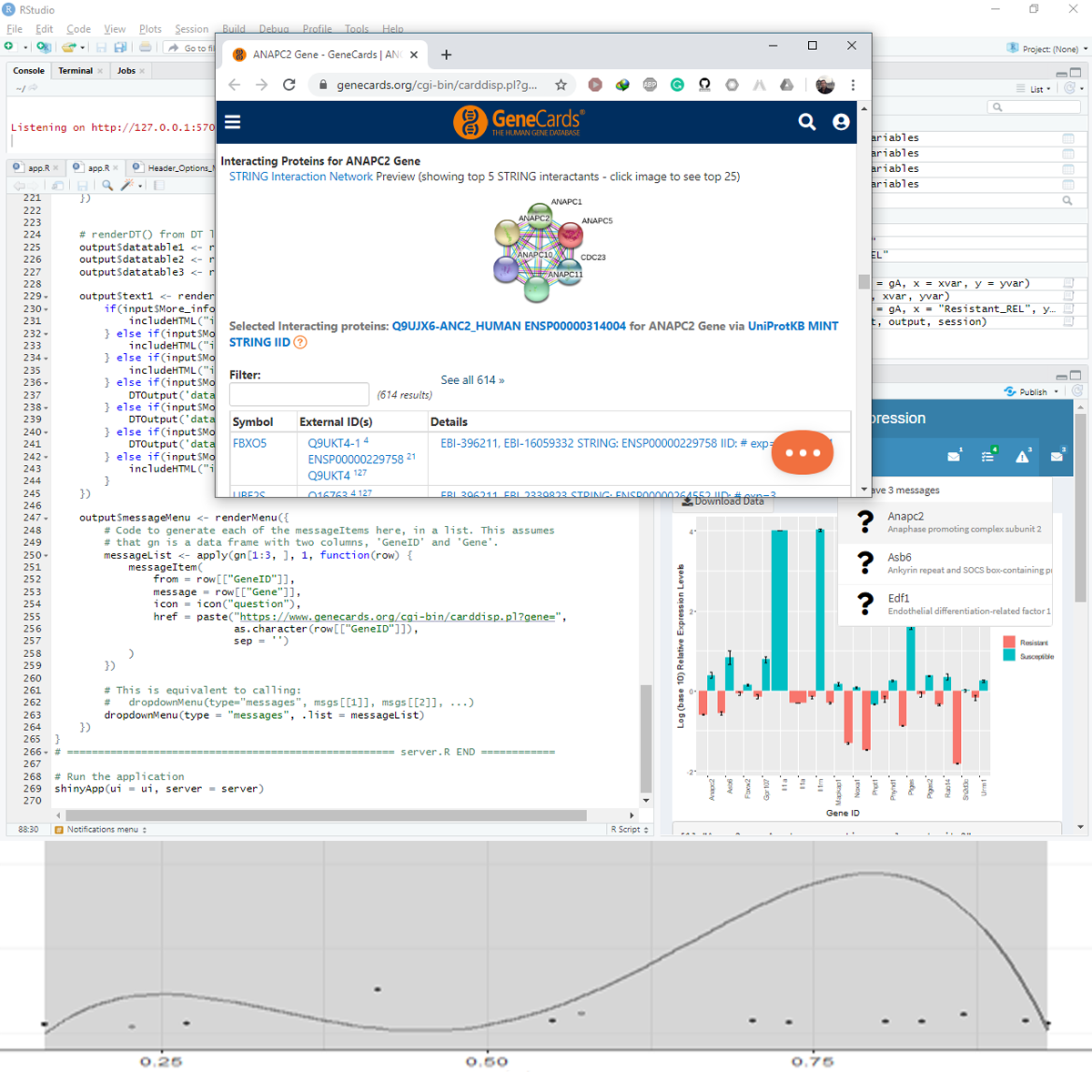
In this project-based course, you will create a Shiny app to plot gene expression data (Real-Time PCR) from a published manuscript. You will build the Shiny app from scratch and handle every component of Shiny. The project covers data processing and collecting feedback from the user to build and finetune the output.
In this course, we will be concerned with the optimal use of inputs and outputs. Instead of building a lot of inputs and outputs, we will use a limited number of components and recycle some even seven times for different purposes.
What's inside
Syllabus
Good to know
Save this course
Reviews summary
Useful shiny app creation tutorial
Activities
Compile a List of Useful Shiny Resources
Show steps
Increase your knowledge of Shiny resources by compiling a comprehensive list of useful articles, tutorials, and tools
Browse courses on
Resources
Show steps
-
Search for and gather relevant Shiny resources
-
Organize and categorize the resources
-
Share the compilation with others
Review the Book 'Mastering Shiny'
Show steps
Gain a comprehensive understanding of Shiny app development by reviewing a seminal book on the subject
Show steps
-
Read the book thoroughly
-
Take notes on key concepts and techniques
-
Apply what you learn to your own Shiny apps
Follow Shiny Tutorials
Show steps
Develop proficiency in using Shiny by following guided tutorials
Browse courses on
Data Visualization
Show steps
-
Find relevant Shiny tutorials
-
Follow the tutorials step-by-step
-
Replicate the examples in your own apps
Four other activities
Expand to see all activities and additional details
Show all seven activities
Build the Shiny App from Scratch
Show steps
Increase understanding of Shiny and programming concepts by creating a Shiny app from scratch
Browse courses on
Programming
Show steps
-
Set up your development environment
-
Create a new Shiny app project
-
Add the necessary packages
-
Write the R code for the app
-
Test and debug the app
Join a Shiny App Development Study Group
Show steps
Improve your problem-solving abilities and gain new perspectives by collaborating with peers
Browse courses on
Collaboration
Show steps
-
Find a study group or create your own
-
Meet regularly to discuss Shiny app development topics
-
Work on projects together
Create a Video Tutorial on Shiny App Development
Show steps
Enhance your understanding of Shiny app development by creating a video tutorial that explains the process
Browse courses on
Data Visualization
Show steps
-
Plan the content of your tutorial
-
Record the video
-
Edit and produce the video
-
Publish your video on a video-sharing platform
Participate in a Shiny App Development Competition
Show steps
Enhance your development skills and solve real-world problems by participating in a competition
Browse courses on
Problem-Solving
Show steps
-
Find an appropriate competition
-
Develop a Shiny app that addresses the competition's challenge
-
Submit your app for consideration
Compile a List of Useful Shiny Resources
Show steps
Increase your knowledge of Shiny resources by compiling a comprehensive list of useful articles, tutorials, and tools
Browse courses on
Resources
Show steps
- Search for and gather relevant Shiny resources
- Organize and categorize the resources
- Share the compilation with others
Review the Book 'Mastering Shiny'
Show steps
Gain a comprehensive understanding of Shiny app development by reviewing a seminal book on the subject
Show steps
- Read the book thoroughly
- Take notes on key concepts and techniques
- Apply what you learn to your own Shiny apps
Follow Shiny Tutorials
Show steps
Develop proficiency in using Shiny by following guided tutorials
Browse courses on
Data Visualization
Show steps
- Find relevant Shiny tutorials
- Follow the tutorials step-by-step
- Replicate the examples in your own apps
Build the Shiny App from Scratch
Show steps
Increase understanding of Shiny and programming concepts by creating a Shiny app from scratch
Browse courses on
Programming
Show steps
- Set up your development environment
- Create a new Shiny app project
- Add the necessary packages
- Write the R code for the app
- Test and debug the app
Join a Shiny App Development Study Group
Show steps
Improve your problem-solving abilities and gain new perspectives by collaborating with peers
Browse courses on
Collaboration
Show steps
- Find a study group or create your own
- Meet regularly to discuss Shiny app development topics
- Work on projects together
Create a Video Tutorial on Shiny App Development
Show steps
Enhance your understanding of Shiny app development by creating a video tutorial that explains the process
Browse courses on
Data Visualization
Show steps
- Plan the content of your tutorial
- Record the video
- Edit and produce the video
- Publish your video on a video-sharing platform
Participate in a Shiny App Development Competition
Show steps
Enhance your development skills and solve real-world problems by participating in a competition
Browse courses on
Problem-Solving
Show steps
- Find an appropriate competition
- Develop a Shiny app that addresses the competition's challenge
- Submit your app for consideration
Career center
Data Analyst
Biostatistician
Research Scientist
Data Visualization Engineer
Web Developer
Software Engineer
Data Journalist
Bioinformatician
Quantitative Analyst
Operations Research Analyst
Market Research Analyst
Business Analyst
Statistician
Machine Learning Engineer
Data Scientist
Reading list
Share
Similar courses
OpenCourser helps millions of learners each year. People visit us to learn workspace skills, ace their exams, and nurture their curiosity.
Our extensive catalog contains over 50,000 courses and twice as many books. Browse by search, by topic, or even by career interests. We'll match you to the right resources quickly.
Find this site helpful? Tell a friend about us.
We're supported by our community of learners. When you purchase or subscribe to courses and programs or purchase books, we may earn a commission from our partners.
Your purchases help us maintain our catalog and keep our servers humming without ads.
Thank you for supporting OpenCourser.



